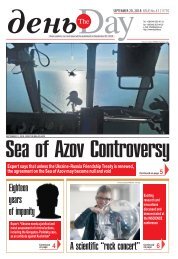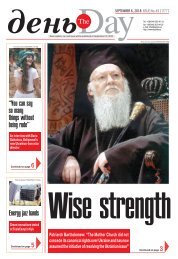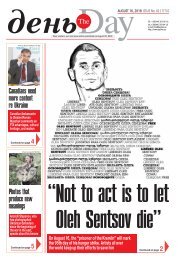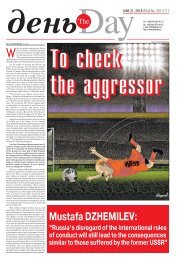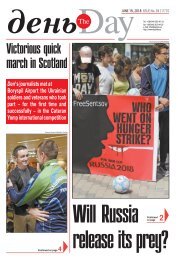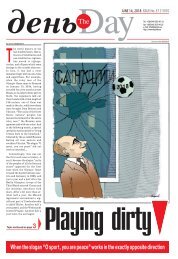#15_1-8
You also want an ePaper? Increase the reach of your titles
YUMPU automatically turns print PDFs into web optimized ePapers that Google loves.
6<br />
No.15 MARCH 6, 2018<br />
CLOSE UP<br />
WWW.DAY.KIEV.UA<br />
By Maria PROKOPENKO, photos by<br />
Artem SLIPACHUK, The Day<br />
Ukrainian school students<br />
annually create up to<br />
500 inventions. These designs<br />
can facilitate rescue operations,<br />
say, during fires, automate<br />
certain business processes or improve the<br />
state of the environment. But most of<br />
these ideas never come to fruition. Their<br />
authors lack knowledge of how to submit<br />
their creative products to an investor and<br />
have no way to contact these investors.<br />
Many inventors are grouped in the<br />
Junior Academy of Sciences (JAS). Therefore,<br />
the JAS initiated the first state-run<br />
business incubator for high school students,<br />
which is called the UF Incubator and<br />
is being created now. The name stands for<br />
the Ukrainian Future Incubator. The project<br />
went operational in February, but not<br />
to the full extent yet. At present, participants<br />
in the incubation program attend the<br />
ManLab laboratory once a month, where<br />
they learn the basics of marketing, business<br />
plan making, and idea promotion. Meanwhile,<br />
at the end of this year, a large facility<br />
at 13, Chokolivskyi Boulevard, the building<br />
once housing the Yerevan Cinema,<br />
will open and make available spaces for lectures<br />
and other educational events, prototyping,<br />
etc.<br />
Head of the UF Incubator Vitalii<br />
Lisovyi told us about the project’s current<br />
condition and showed how it would look like<br />
in six months. Meanwhile, the first participants<br />
of the incubation program used<br />
us for training in presenting their projects.<br />
● RUBBER WASTE<br />
15-year-old Danylo Kovalenko, who is<br />
studying at the Polytechnic Lyceum of<br />
Kyiv Polytechnic Institute (KPI), wants to<br />
grant a new life to used tires. “No one has<br />
ever invented such a thing! The technique<br />
involves deep cooling of the tires with liquid<br />
nitrogen, and then subjecting them to<br />
ultrasound, which breaks them into small<br />
bits. These bits can be used to make rubber<br />
products of every kind,” the high school<br />
student explained.<br />
Now the tires are either stored or<br />
burned. It is harmful to the environment,<br />
and potentially reusable raw material is lost<br />
as well. Kovalenko’s technique is environmentally<br />
friendly, cost-effective, and<br />
has no analogues.<br />
“Another advantage of this technique<br />
is the absence of direct contact between the<br />
machine’s parts and tires. After all, for example,<br />
there is a technique for processing<br />
of tires in a kind of ‘meat grinder.’ There<br />
is a very high wear and tear of equipment<br />
involved. Our machine, meanwhile, works<br />
remotely, and we do not have to replace the<br />
worn parts every month,” the student<br />
added. “There is another remotely working<br />
technique, which involves processing tires<br />
with ozone, but it is environmentally<br />
harmful and quite dangerous because<br />
ozone is an unstable substance. Therefore,<br />
I think our technique faces no real<br />
competition.”<br />
Kovalenko has already tested his technique<br />
and even patented it. But the power<br />
capacity used during the test was low.<br />
“We worked with installations having<br />
power output of 50 and 250 watts, although<br />
the test requires at least 4,000<br />
watts to make everything obvious. Such installations<br />
are very expensive, and we need<br />
investment to get them. But this technique<br />
works,” the student assured us.<br />
The designer has developed the concept<br />
of a plant where tires would be processed<br />
by ultrasound. But he needs to carry out<br />
tests on powerful installations first, and<br />
calculate how many tires can be processed<br />
per hour. Kovalenko has lately written to<br />
international tire-making companies to<br />
interest them in his technique. The kid<br />
hopes that the business incubator will<br />
help with the search for an investor and<br />
promotion of the project.<br />
● FOR THE YOUNGEST<br />
INNOVATORS<br />
It is believed that the first business incubator<br />
appeared in the US in the late<br />
1950s, it was founded by Joseph Mancuso.<br />
It became a trend in the 1990s. “Globally,<br />
there are profit-making business incubators<br />
that are created by private companies,<br />
Ideas, come out!<br />
How the first state-run business<br />
incubator for school students operates<br />
VITALII LISOVYI<br />
and there are those that function in educational<br />
institutions,” Lisovyi said. “Most<br />
leading US universities, such as ones located<br />
in Massachusetts or Florida, have<br />
business incubators for students who can<br />
implement their projects there. Almost all<br />
countries of the EU have a developed network<br />
of such incubators: Estonia, Finland,<br />
Germany, Poland, etc. We are an academic<br />
institution, we are engaged in the<br />
science education of highschoolers, therefore<br />
creating a business incubator in our<br />
structure is logical.”<br />
It is noteworthy that the UF Incubator<br />
focuses on highschoolers, while similar entities<br />
typically work with college students.<br />
“For many years, the JAS has conducted<br />
a competition for youth innovation<br />
projects, called the Future of Ukraine.<br />
There, kids annually present their best inventions,<br />
prototypes, projects. Actually,<br />
this competition has inspired the creation<br />
of a business incubator. The kids who take<br />
part in it are talented and have ready-made<br />
solutions that can compete with those proposed<br />
by adults. Their inventions have to<br />
do with robotics, instrument-making industry,<br />
materials science, electronics, etc.<br />
But often enough, these kids do not have<br />
the opportunity to implement their projects<br />
in the business environment, commercialize<br />
them,” Lisovyi continued. “The<br />
main task of our business incubator is to<br />
help kids gain business education skills.<br />
They want to know how to present their<br />
product, how to persuade an investor to finance<br />
a project, how to work in a team,<br />
which promotion strategy to choose, and so<br />
on. Our task is also to help kids to patent<br />
their designs.”<br />
● “IF YOU HAVE A COOL IDEA,<br />
YOU MAY COME AND<br />
WORK HERE”<br />
The manager showed us the technical<br />
passport of the location which will appear<br />
in Chokolivskyi Boulevard. “There will be<br />
a coworking there, where kids who would<br />
get into the incubation program will be<br />
able to work. They will be able to use office<br />
equipment, have a place to work.<br />
There will also be a film lecture hall seating<br />
250, which will host lectures, training<br />
sessions, meetings with successful startuppers,”<br />
recounted the head of the UF Incubator.<br />
“The prototype laboratory will<br />
operate there, with 3D printers, a soldering<br />
station, and milling machines<br />
available. Our experts will help everyone<br />
to use it.”<br />
The UF Incubator will be able to host<br />
eight teams at the same time which will be<br />
selected by competition. Each team will include<br />
8 to 10 participants. “However, if you<br />
do not belong to a team, but have a cool<br />
idea, you may come and work here, it is not<br />
a problem,” Lisovyi added. The incubation<br />
program will last from 3 to 10 weeks, totally<br />
depending on the level of readiness of<br />
the project and the composition of the<br />
team that will work on it.<br />
While the center is under construction,<br />
young designers are attending training sessions<br />
and lectures. The next event will be<br />
held in late March and will be devoted to<br />
fundraising. And in the summer, the incubator<br />
team wants to hold a startup<br />
school. To select participants, it will announce<br />
a competition. If one has an interesting<br />
idea, they can apply, and experts will<br />
select the most interesting projects.<br />
● “DESIGNS SHOULD MAKE<br />
LIFE EASIER OR PROTECT IT”<br />
While we were talking with Lisovyi, a<br />
student of KPI’s Polytechnic Lyceum Serhii<br />
Lysin approached us. The kid, who is 14,<br />
is developing a fire-fighting robot with a<br />
computer vision-based homing system.<br />
“We have analyzed the existing prototypes<br />
of fire-fighting robots and seen that<br />
it is difficult to control them. A person<br />
must be present when they are extinguishing<br />
the fire. Therefore, we have decided<br />
to automate this process a bit and created<br />
a computer vision system, which allows<br />
the robot to autonomously look for a<br />
fire and extinguish it,” Lysin described his<br />
idea. A prototype of the robot stood next<br />
to him, and the kid connected it to the computer<br />
and showed us how it worked. Of<br />
course, we did not ignite a fire beforehand.<br />
The designer translated an RGB image<br />
that reflected the way we see in normal life<br />
into the HSV format. The robot reacts to<br />
moving red contours, which it identifies as<br />
a fire. On the monitor, they look green.<br />
Lysin also showed how it was tested in conditions<br />
approximating real life. A small robot<br />
travels fast and looks for a fire, and<br />
when it identifies one, it uses a firefighting<br />
hose to smother it.<br />
“So far, people have to be present for<br />
some time when extinguishing fires, but we<br />
are improving the process,” the student<br />
commented. “It is just a prototype. We<br />
want to add another plane for the computer<br />
vision system, to design a case for it. To use<br />
such a robot in forests and at large enterprises,<br />
oil terminals, we need to make it bigger.<br />
Also, I am learning a new programming<br />
language right now, and we will create<br />
a better model using it.”<br />
Lysin worked on this project together<br />
with his research adviser for several<br />
months. He had invented some designs before,<br />
but called them “less serious.” However,<br />
all of them were intended to make rescue<br />
operations work better. “My first idea<br />
was a demining robot. I wanted to make a<br />
device that would go about carrying a<br />
metal detector and looking for mines.<br />
Every mine has iron inside. I thought that<br />
it was possible to make a metal detector that<br />
would find mines, and it would be safer for<br />
humans. But I then faced many problems<br />
designing it, and realized that it would be<br />
unrealistically expensive,” the kid recalled.<br />
“Then I and my partner came up<br />
with a modular rescue robot. It was like a<br />
caterpillar that could get into hard-toreach<br />
places and look for people. I think<br />
that all designs should make life easier or<br />
protect people.”<br />
● A NEW APPROACH<br />
TO GARDENING<br />
The projects of the first students of the<br />
UF Incubator are not only about machines.<br />
Den covered before the story of Ukrainian<br />
gardening beginning in the hills around the<br />
Kyiv Monastery of the Caves. The 11thgrader<br />
Svitlana Shuhailo created a model<br />
of the Paradise Garden, which she proposes<br />
to plant on the monastery’s grounds.<br />
“The idea occurred to me when I<br />
walked around the Kyiv Caves Sanctuary<br />
and stumbled upon a not very attractive<br />
tract. There were lots of construction debris<br />
there. I thought: ‘Why not create a garden<br />
in this place, which would become an<br />
ornament of the city?’” Shuhailo shared her<br />
thoughts with us.<br />
While attending the JAS, the highschooler<br />
wrote a paper on the basic principles<br />
of the organization of monastery gardens<br />
from the Middle Ages to the Baroque<br />
Age. The garden which Shuhailo proposes<br />
to create in Kyiv is to be formed along the<br />
same principles. “This is an ideal resting<br />
place for everyone! One can sit near the<br />
fountain and feel the aroma of lavender<br />
planted next to it. People who are tired of<br />
urban life can retire into rose-lined pergolas.<br />
There is also a medicinal herb garden<br />
within it, featuring spicy aromatic<br />
plants. There should be fruit trees and<br />
berry shrubs there as well: apple trees<br />
and raspberry shrubs, with different<br />
species of currants planted along the<br />
perimeter of garden trails. Each quarter of<br />
the garden should have a mixed border, a<br />
flower bed that changes with every season,”<br />
the highschooler said while conducting a<br />
virtual tour.<br />
The girl observed that potentially,<br />
the garden could even be profitable as a<br />
source of plant material for all kinds of tea,<br />
soap, etc. Also, every plant here has a symbolic<br />
meaning.<br />
“I brought this project to the Kyiv<br />
Startup Festival last year, and it became<br />
clear that people needed a product that<br />
brings profits right now,” Shuhailo stated.<br />
“A garden is a bit different, as the implementation<br />
of such a project takes time.<br />
That was why I got interested in the business<br />
incubator: having an idea is nice,<br />
but who needs it if you cannot convey its<br />
importance? In my case, it is the fact that<br />
one can make money also through gardens,<br />
while bringing benefits to people.”<br />
● “ATTRACTING OUR<br />
BUSINESSPEOPLE WOULD<br />
BE COOL”<br />
Lysin has a similar motivation. “The<br />
incubator lets me promote my project in the<br />
future. Because if I invent something,<br />
and then sit at home and do not tell anyone<br />
about it, it would be illogical,” the boy<br />
mused.<br />
Private incubators do exist in Ukraine,<br />
but their approach is different from that<br />
of the UF Incubator. Lisovyi said: “As a<br />
rule, private business incubators want to<br />
have something real that can be put into<br />
production tomorrow. We want to help develop<br />
the idea. We choose the best and help<br />
them.”<br />
Some projects of JAS students have already<br />
found support from investors and<br />
grown into innovative companies. But<br />
these are isolated cases, and the UF Incubator<br />
wants to see more of them. Lisovyi optimistically<br />
maintained that projects created<br />
by Ukrainian school students might<br />
potentially be of interest to businesspeople<br />
from many countries. But he added: “First<br />
of all, it would be great for the nation if<br />
Ukrainian businesspeople started investing<br />
in us. There are technology companies<br />
in Ukraine that may be interested in such<br />
designs.”




